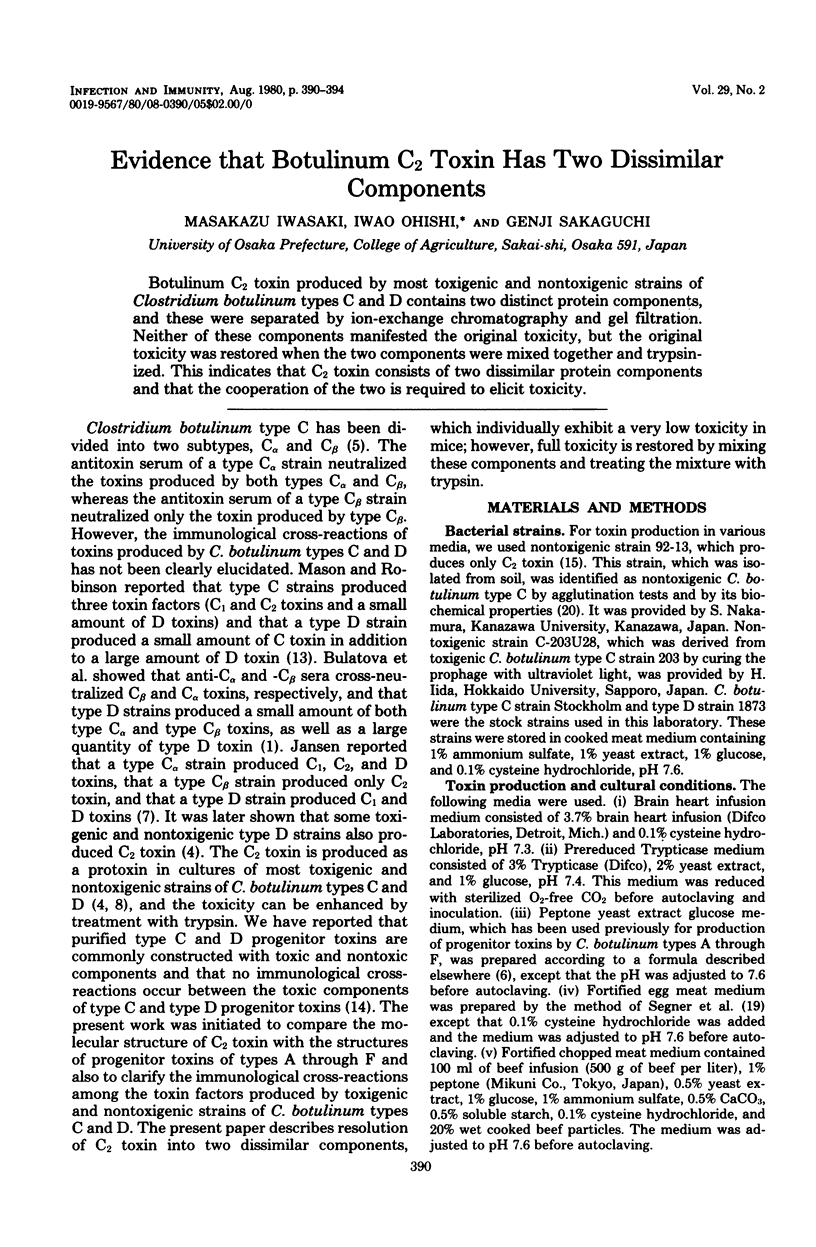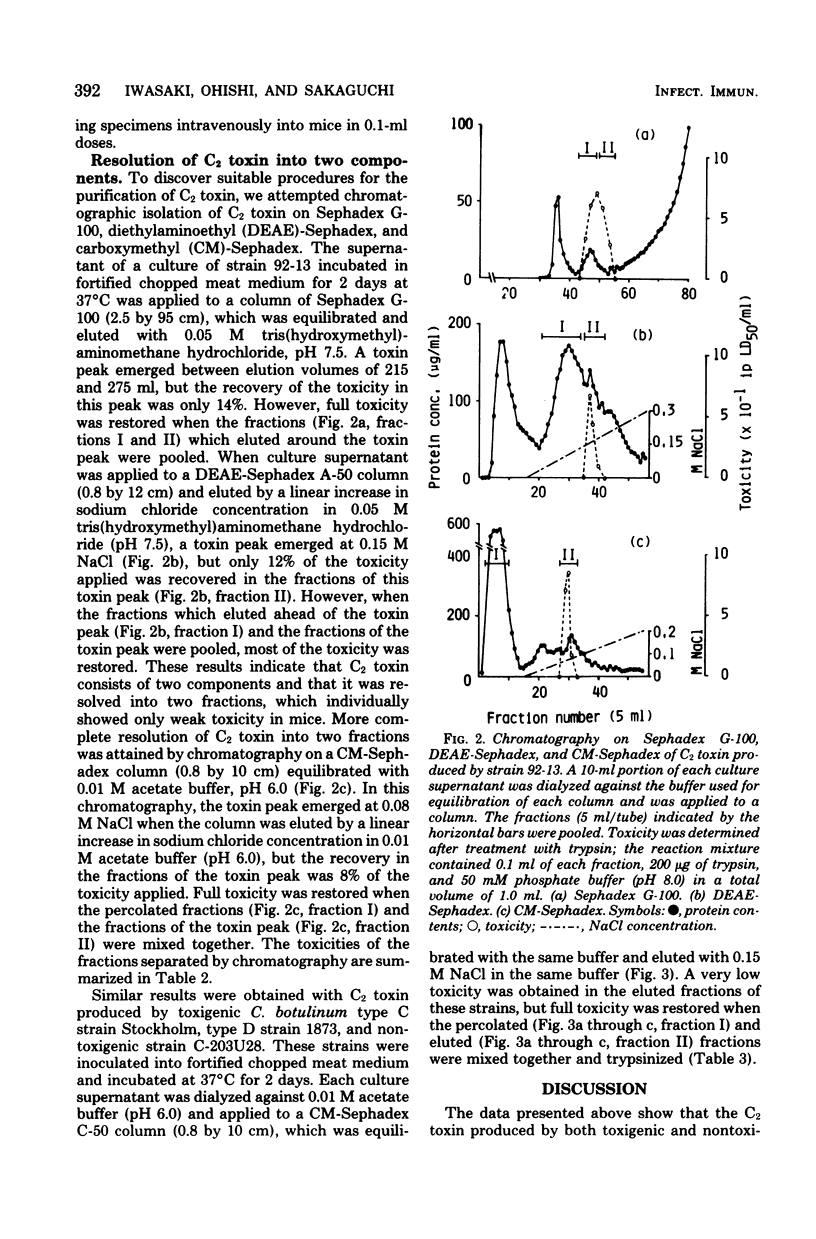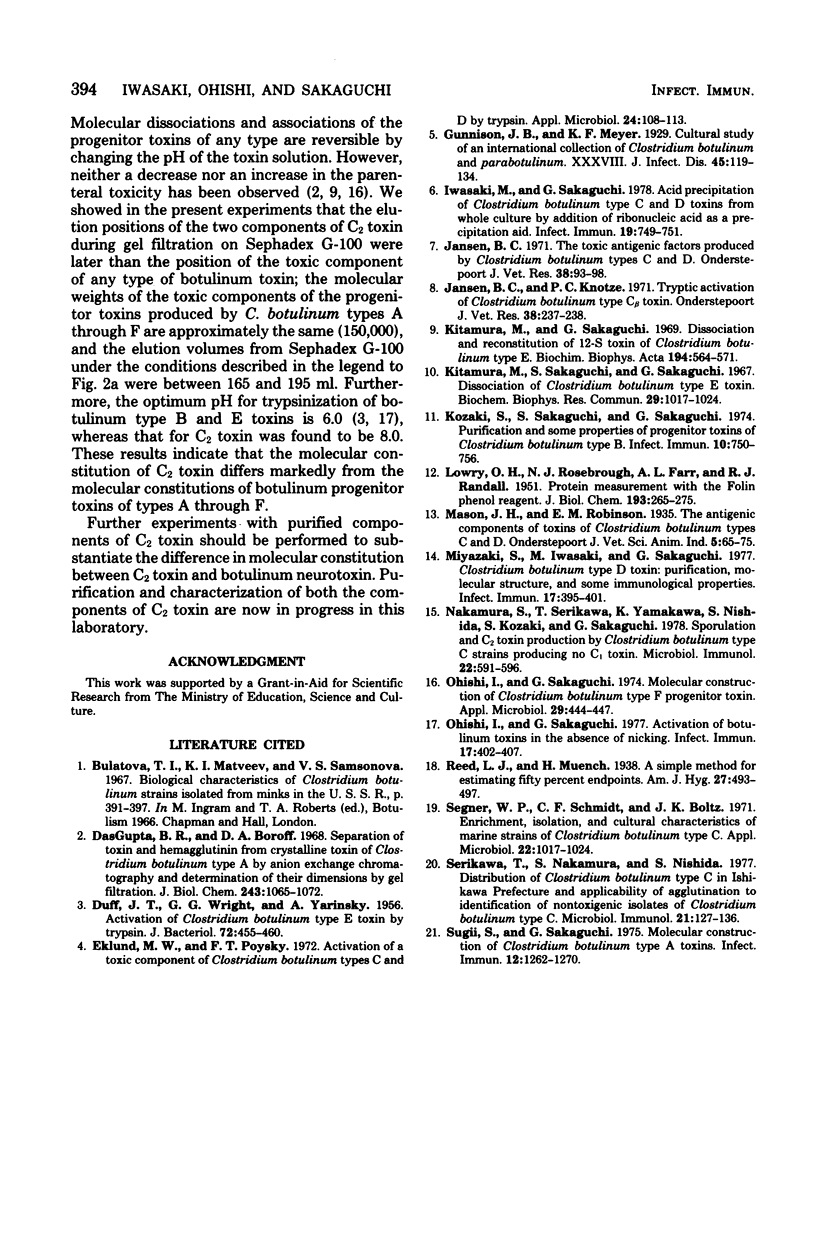Abstract
Botulinum C2 toxin produced by most toxigenic and nontoxigenic strains of Clostridium botulinum types C and D contains two distinct protein components, and these were separated by ion-exchange chromatography and gel filtration. Neither of these components manifested the original toxicity, but the original toxicity was restored when the two components were mixed together and trypsinized. This indicates that C2 toxin consists of two dissimilar protein components and that the cooperation of the two is required to elicit toxicity.
Full text
PDF




Selected References
These references are in PubMed. This may not be the complete list of references from this article.
- DUFF J. T., WRIGHT G. G., YARINSKY A. Activation of Clostridium botulinum type E toxin by trypsin. J Bacteriol. 1956 Oct;72(4):455–460. doi: 10.1128/jb.72.4.455-460.1956. [DOI] [PMC free article] [PubMed] [Google Scholar]
- DasGupta B. R., Boroff D. A. Separation of toxin and hemagglutinin from crystalline toxin of Clostridium botulinum type A by anion exchange chromatography and determination of their dimensions by gel filtration. J Biol Chem. 1968 Mar 10;243(5):1065–1072. [PubMed] [Google Scholar]
- Eklund M. W., Poysky F. T. Activation of a toxic component of Clostridium botulinum types C and D by trypsin. Appl Microbiol. 1972 Jul;24(1):108–113. doi: 10.1128/am.24.1.108-113.1972. [DOI] [PMC free article] [PubMed] [Google Scholar]
- Iwasaki M., Sakaguchi G. Acid precipitation of Clostridium botulinum type C and D toxins from whole culture by addition of ribonucleic acid as a precipitation aid. Infect Immun. 1978 Feb;19(2):749–751. doi: 10.1128/iai.19.2.749-751.1978. [DOI] [PMC free article] [PubMed] [Google Scholar]
- Jansen B. C., Knoetze P. C. Tryptic activation of Clostridium botulinum type C beta toxin. Onderstepoort J Vet Res. 1971 Dec;38(4):237–238. [PubMed] [Google Scholar]
- Jansen B. C. The toxic antigenic factors produced by Clostridium botulinum types C and D. Onderstepoort J Vet Res. 1971 Jun;38(2):93–98. [PubMed] [Google Scholar]
- Kitamura M., Sakaguchi G. Dissociation and reconstitution of 12-S toxin of Clostridium botulinum type E. Biochim Biophys Acta. 1969 Dec 23;194(2):564–571. doi: 10.1016/0005-2795(69)90118-4. [DOI] [PubMed] [Google Scholar]
- Kozaki S., Sakaguchi S., Sakaguchi G. Purification and some properties of progenitor toxins of Clostridium botulinum type B. Infect Immun. 1974 Oct;10(4):750–756. doi: 10.1128/iai.10.4.750-756.1974. [DOI] [PMC free article] [PubMed] [Google Scholar]
- LOWRY O. H., ROSEBROUGH N. J., FARR A. L., RANDALL R. J. Protein measurement with the Folin phenol reagent. J Biol Chem. 1951 Nov;193(1):265–275. [PubMed] [Google Scholar]
- Miyazaki S., Iwasaki M., Sakaguchi G. Clostridium botulinum type D toxin: purification, molecular structure, and some immunological properties. Infect Immun. 1977 Aug;17(2):395–401. doi: 10.1128/iai.17.2.395-401.1977. [DOI] [PMC free article] [PubMed] [Google Scholar]
- Nakamura S., Serikawa T., Yamakawa K., Nishida S., Kozaki S., Sakaguchi G. Sporulation and C2 toxin production by Clostridium botulinum type C strains producing no C1 toxin. Microbiol Immunol. 1978;22(10):591–596. doi: 10.1111/j.1348-0421.1978.tb00409.x. [DOI] [PubMed] [Google Scholar]
- Ohishi I., Sakaguchi G. Activation of botulinum toxins in the absence of nicking. Infect Immun. 1977 Aug;17(2):402–407. doi: 10.1128/iai.17.2.402-407.1977. [DOI] [PMC free article] [PubMed] [Google Scholar]
- Ohishi I., Sakaguchi G. Molecular construction of Clostridium botulinum type F progenitor toxin. Appl Microbiol. 1975 Apr;29(4):444–447. doi: 10.1128/am.29.4.444-447.1975. [DOI] [PMC free article] [PubMed] [Google Scholar]
- Segner W. P., Schmidt C. F., Boltz J. K. Enrichment, isolation, and cultural characteristics of marine strains of Clostridium botulinum type C. Appl Microbiol. 1971 Dec;22(6):1017–1024. doi: 10.1128/am.22.6.1017-1024.1971. [DOI] [PMC free article] [PubMed] [Google Scholar]
- Serikawa T., Nakamura S., Nishida S. Distribution of Clostridium botulinum type C in Ishikawa prefecture, and applicability of agglutination to identification of nontoxigenic isolates of C. botulinum type C. Microbiol Immunol. 1977;21(3):127–136. doi: 10.1111/j.1348-0421.1977.tb00274.x. [DOI] [PubMed] [Google Scholar]
- Sugii S., Sakaguchi G. Molecular construction of Clostridium botulinum type A toxins. Infect Immun. 1975 Dec;12(6):1262–1270. doi: 10.1128/iai.12.6.1262-1270.1975. [DOI] [PMC free article] [PubMed] [Google Scholar]


